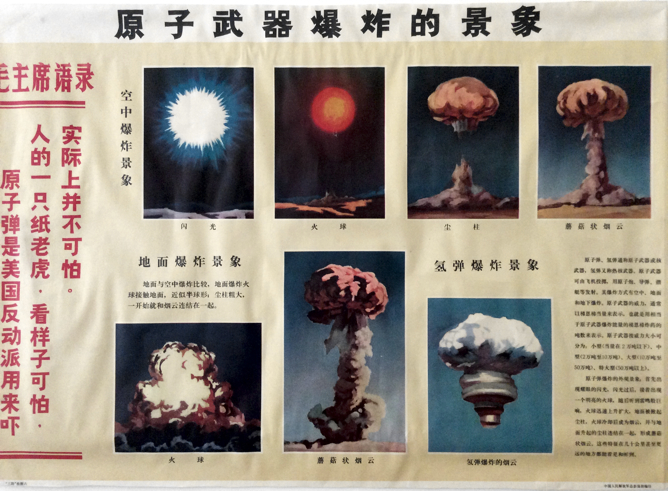Next month, on 16 October, China will commemorate the fiftieth anniversary of its first successful nuclear weapons test. That same day in 1964 the Chinese government released an official statement declaring, “China will never at any time or under any circumstances be the first to use nuclear weapons.” The Chinese government reconfirmed its commitment to that declaration many times over the past five decades, most recently in April 2013.

A propaganda poster on nuclear weapons from the General Command of the People’s Liberation Army circa 1971.
The original statement also contains an explanation of why China decided to develop nuclear weapons. It notes that it was not because China plans to use them, but rather to oppose the “nuclear blackmail and nuclear threats” made by others. Although China’s declaration may appear to be a moral or symbolic act, it also reflects the hard-nosed strategic calculation that there is no imaginable scenario in which using nuclear weapons would end well for China. Taken as a whole, the language expresses the view that self-assurance of immunity to nuclear blackmail is the sole purpose of China’s nuclear arsenal.
Most U.S. analysts of China’s nuclear program never took this statement seriously, especially the no first use pledge. The relatively recent disclosure of a discussion of nuclear weapons policy in a highly classified Chinese military textbook raised new U.S. suspicions about China’s threshold for nuclear use.
A Secret “Adjustment” to Chinese Nuclear Policy?
The focus of U.S suspicion centers on the textbook’s consideration of an exceptional situation in which China is suffering large and sustained conventional attacks from a militarily superior and nuclear-armed enemy. The section of the textbook where this situation is examined suggests the Chinese military may try to stop such attacks by threatening to use its nuclear weapons—announcing targets, conducting launch exercises—as a way of getting the attacker’s attention and trying to coerce the attacker into stopping its attack. The Chinese military calls this “lowering the threshold for nuclear coercion.”
I believe it is clear from a careful reading of this section, in the context of the rest of the book, that the proposed “adjustment” in China’s nuclear policy is intended as a bluff. Unlike U.S. and Russian nuclear threats, which are made publicly and during peacetime, the Chinese military intended its nuclear threat to remain a secret. It was conceived as a surprise China would only spring at a desperate moment in the midst of a war. Unfortunately for the Chinese military planners who devised this stratagem, the classified text detailing their preparations to employ it was leaked to foreign sources and is now available in several U.S. university libraries.
Persistent U.S. Misunderstanding of China’s Nuclear Doctrine
Initial U.S. and Japanese reports about the stratagem mistakenly claimed it called for China to launch a pre-emptive nuclear strike, and unfortunately, many U.S. governmental and non-governmental experts still believe the initial reports. The textbook describes the stratagem as a lowering of China’s threshold for threatening to use its nuclear weapons, not for actually using them. There continues to be a great deal of confusion about the language the Chinese military used to describe the stratagem, perhaps because there is no publicly available English translation of the original Chinese source. So I provide a translation of the relevant section here.
The directions for implementing the “lowering the threshold” stratagem are in the final section of a chapter called “Deterrence Operations” in a military textbook U.S. analysts generally refer to as The Science of Second Artillery Campaigns, but which I prefer to translate as The Science of Second Artillery Operations. The word “campaigns” suggests a discussion of military strategy, but the book is actually a training manual for the officers and soldiers who operate China’s missile forces. It was written by a committee of professional military educators supervised by the General Command of China’s People’s Liberation Army. It was classified “extremely secret” and initially distributed to authorized readers in 2004.
Some U.S. observers think the text is ambiguous on the question of whether or not China would launch a pre-emptive nuclear attack. The relevant section of the text only discusses preparations to carry out a threat gesture, not an attack. What might happen if the bluff fails, however, is difficult to discern if a reader relies only on these final few pages of one chapter in a 405-page book. Reading the rest of the book makes it easier to answer that question with greater confidence.
Throughout The Science of Second Artillery Operations the soldiers and officers who operate China’s nuclear-armed missiles are reminded that China’s no first use doctrine is a fundamental concept of Chinese nuclear planning. An important reminder appears just two pages after the discussion of the bluff in the introduction to the subsequent chapter on “Second Artillery Nuclear Retaliatory Attack Operations,”
“According to our country’s principle, its stand of no first use of nuclear weapons, the Second Artillery will carry out a nuclear missile attack against the enemy’s important strategic targets, according to the combat orders of the Supreme Command, only after the enemy has carried out a nuclear attack against our country.”
U.S. decision-makers who look with skepticism on China’s initial statement fifty years ago may still not find this credible. But my reading of the recently disclosed Chinese text reveals nothing in the language that throws additional doubt on China’s no first use policy.
Moreover, during interviews conducted in Beijing two years ago, officials from China’s nuclear weapons laboratory who advise the senior political leadership on nuclear weapons policy told me the bluff discussed in The Science of Second Artillery Operations is unlikely to be approved by China’s senior political leaders, even in the most desperate of situations. Given the uncertainties surrounding the stratagem, which are discussed in the translated text—including the risk it could cause an adversary to launch a preemptive nuclear strike—this is not surprising.
For the time being, at least, it appears that China’s nuclear threshold has not changed.
